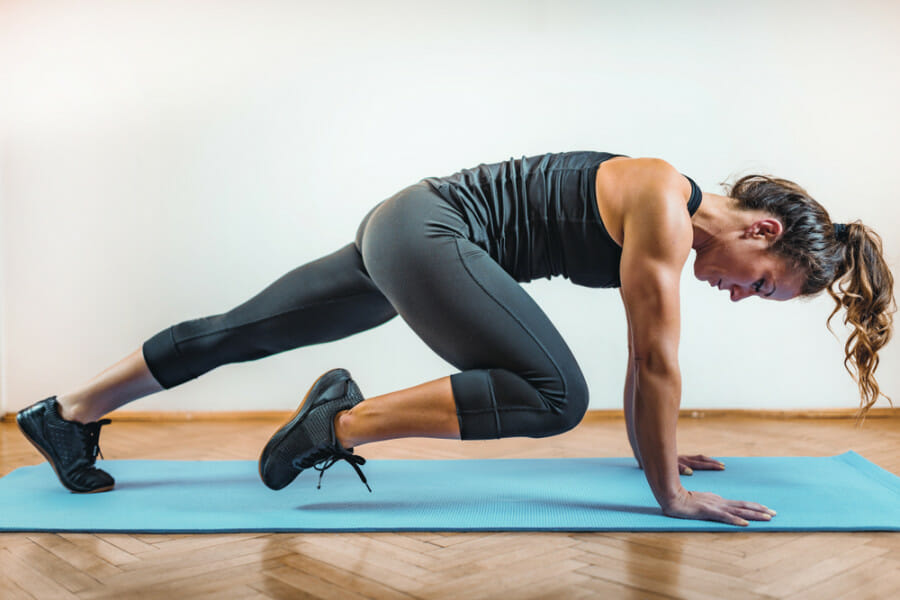This Is How You Can Do A HIIT Workout With Elliptical Machine
When you think of HIIT workouts, you likely imagine bootcamp classes like Barry’s, Orangetheory, or Tone House, aka the hardest workout in America. These intense boutique fitness classes, while modifiable, offer a heart-pumping workout experience that’s bound to leave you breathless, if not aching soon after. That’s one of the biggest downfalls of so many HIIT classes: They can be incredibly high impact, putting your muscles, ligaments, and joints at risk with each lift, jump, and bear crawl. Thankfully, low-impact HIIT workouts exist, too, including HIIT workouts with an elliptical.
Yep, you don’t have to shell out the big bucks for an effective low-impact, high-intensity workout. You can go right over to your gym and hop on an elliptical for a body-quaking regimen that won’t jeopardize your joints.
The benefits of doing HIIT workouts on an elliptical
“Elliptical workouts are a great way to get a challenging cardiovascular workout that is both low impact, and high intensity,” says BowFlex advisor Amy Schemper, CPT. “Elliptical workouts allow you to work to your fitness level by changing your resistance and speed accordingly.”
Additionally, HIIT workouts on ellipticals get your heart pumping in record time, making them super effective for high-intensity interval training and cardio alike. “It only takes a few minutes to boost your heart rate,” Schemper says. “By increasing your speed, resistance, or both, you can increase the intensity of your workout. If you are looking for a quick cardio and energy boost, aim for five to 10 minutes on the elliptical with varying resistance; if longer endurance training is your goal, 20 to 30 minutes or more at a steady resistance and speed is ideal.”
A major highlight of elliptical workouts is that they’re accessible for all strength and endurance levels. “Ellipticals work for beginners, who just want to hop on and start moving, as well as more advanced exercisers, who utilize the resistance and speed for HIIT and endurance training,” Schemper says.
Another highlight? You can easily multitask while working out on an elliptical—even if you’re going all out. Whether you’re at the gym or at home, you can watch your favorite shows, listen to entertaining podcasts, or even read a book.
How to do a HIIT workout with an elliptical
Simply hopping on the elliptical and moseying along won’t give you the blood-pumping effect of HIIT. To significantly boost your heart rate, Schemper says you need to tailor the resistance and be mindful of the size of your steps and where you’re putting your hands.
“Your resistance will be determined by a number of factors: your individual fitness level, how long you’ll be on the elliptical, and what your workout goals are,” she says. “It’s a good idea to start with a quick warm-up of a few minutes at a low resistance—between one to three minutes—then progress to a resistance that makes it a little more challenging during the bulk of the workout. If you’re working in intervals, you can increase your intensity or speed for a short burst of 20 to 30 seconds, then recover at a lower resistance for 30 to 90 seconds.”
When it comes to increasing intensity, you want to work at 70–90 percent of your maximum heart rate during work intervals. So on rate of perceived exertion (RPE) scale, that’s a seven to nine out of 10, with 10 being all-out effort.
The reason the size of your steps matter is because stride plays a direct role in how fast you’ll be able to move. “Your stride length on the elliptical should resemble your own walking or running pace, so it’s important to be moving comfortably,” Schemper says. “Taking smaller steps allows you to increase your speed, but decrease your resistance, often working the calf muscles more intensely; larger steps increase your resistance, working all your lower-body muscles and improving range of motion.”
Lastly, your hands. According to Schemper, hold onto the handles. Unlike holding onto a treadmill mid-stride, using your hands on an elliptical doesn’t cheat your muscles. Rather, it makes you more stable, allowing you to exercise more safely, while also providing a full-body workout.
“The handles provide safety and form and can increase muscle involvement in your workout—use them to maintain proper posture, keeping your chest open, shoulders back, and core engaged,” she says, noting that it’s fine to lean forward slightly, so long as you can maintain a straight spine. “The handles are also connected to the resistance of the elliptical, allowing you to push and pull with your upper body. This affords you an opportunity to engage your arms, shoulders, back, and core, while also taking some of the load off your legs.”
HIIT elliptical workouts to try
Now that you know the importance of resistance, stride, and hand grip, it’s time to talk sequences. According to Schemper, it’s best to keep it simple. “After a two to three minute warm-up, increase your resistance, speed, or incline for 30 seconds, then decrease for a 60-second recovery,” she instructs. During recovery, think about dialing things back to a two to five on the RPE scale, depending on how hard you’re working.
Another option? Maintain your intensity for the duration of your work out, but changing the resistance. To do so, follow Schemper’s guidelines, below.
10 Minute HIIT: (Complete a 2–3 minute warm-up at a low intensity before starting the workout below.)
- Minute 1: Resistance 1
- Minute 2: Resistance 3
- Minute 3: Resistance 2
- Minute 4: Resistance 5
- Minute 5: Resistance 4
- Minute 6: Resistance 7
- Minute 7: Resistance 6
- Minute 8: Resistance 9
- Minute 9: Resistance 8
- Minute 10: Cooldown: Resistance 2–3
Lastly, Schemper suggests a pyramid HIIT workout. Following a two to three minute warm-up at a low resistance, she says to increase the resistance by one for one minute. Once the 60 seconds are complete, rest for 60 seconds, then increase the resistance to the next level (so level 2). Once you hit the top of your pyramid, rest for 60 seconds, then work your way back down in the same fashion.
Ultimately, the length of your pyramid workout will depend on how much time you have, but as a general rule of thumb, HIIT workout should be no more than 30 minutes, it you’re truly going all out.















